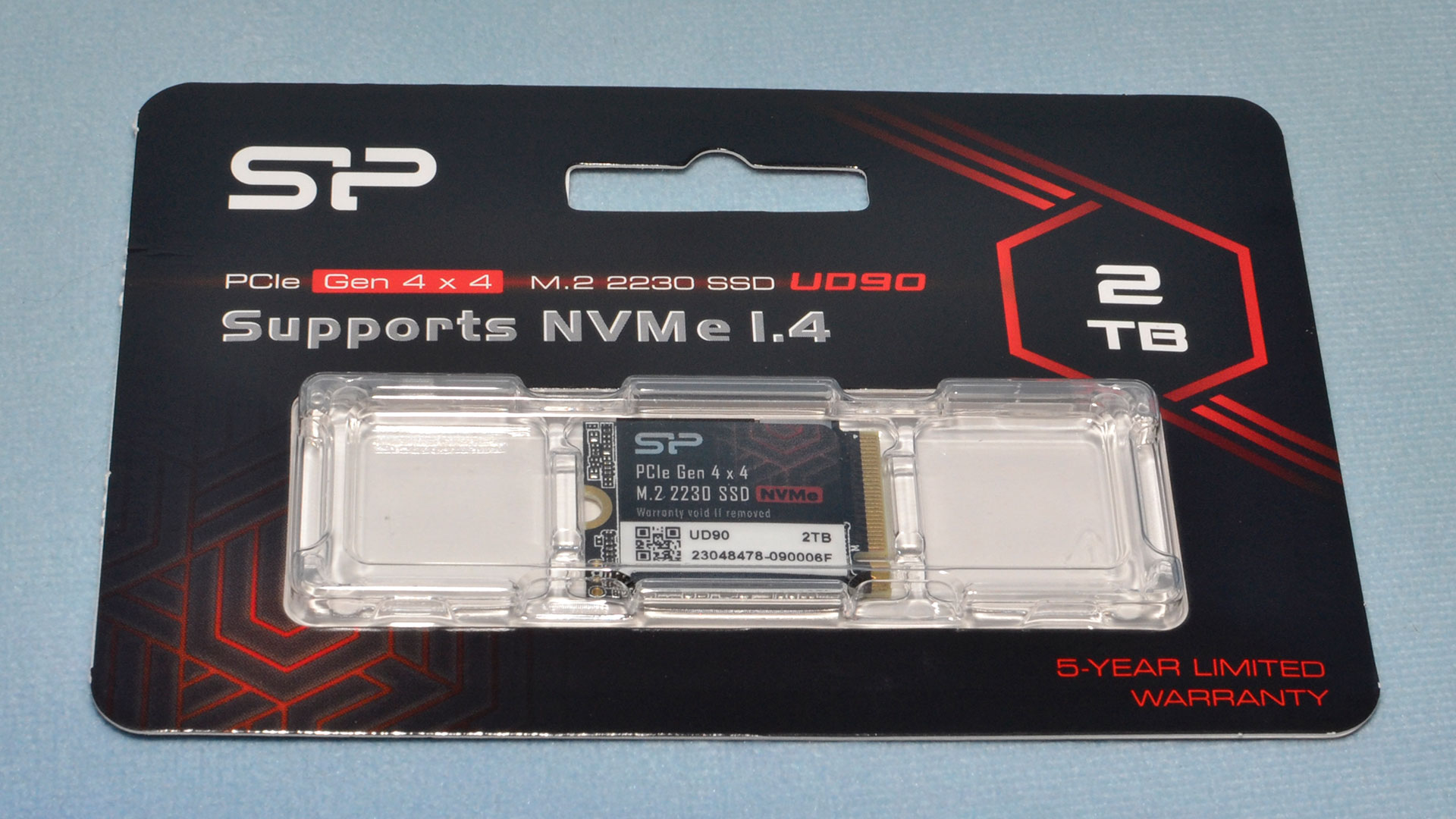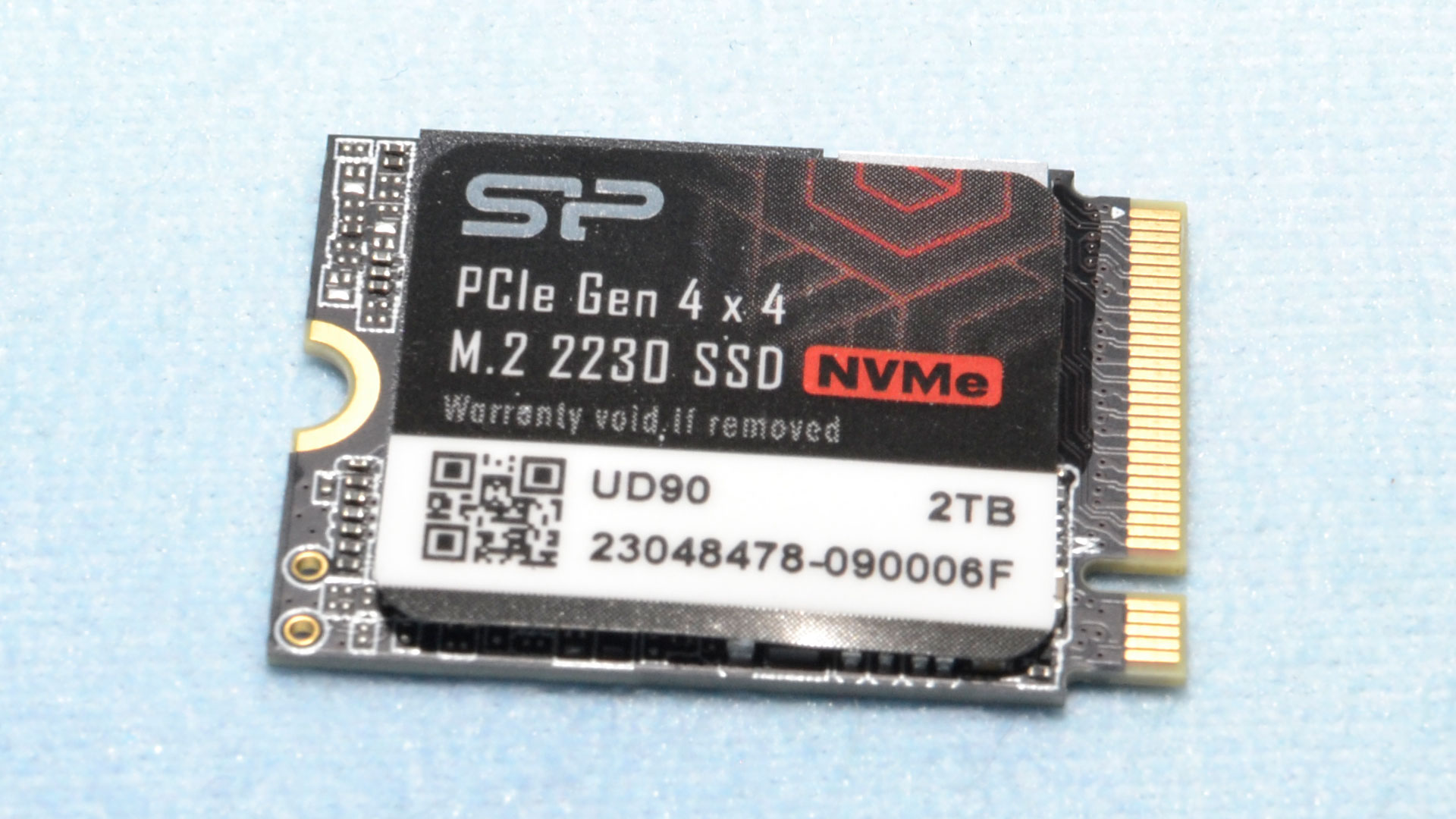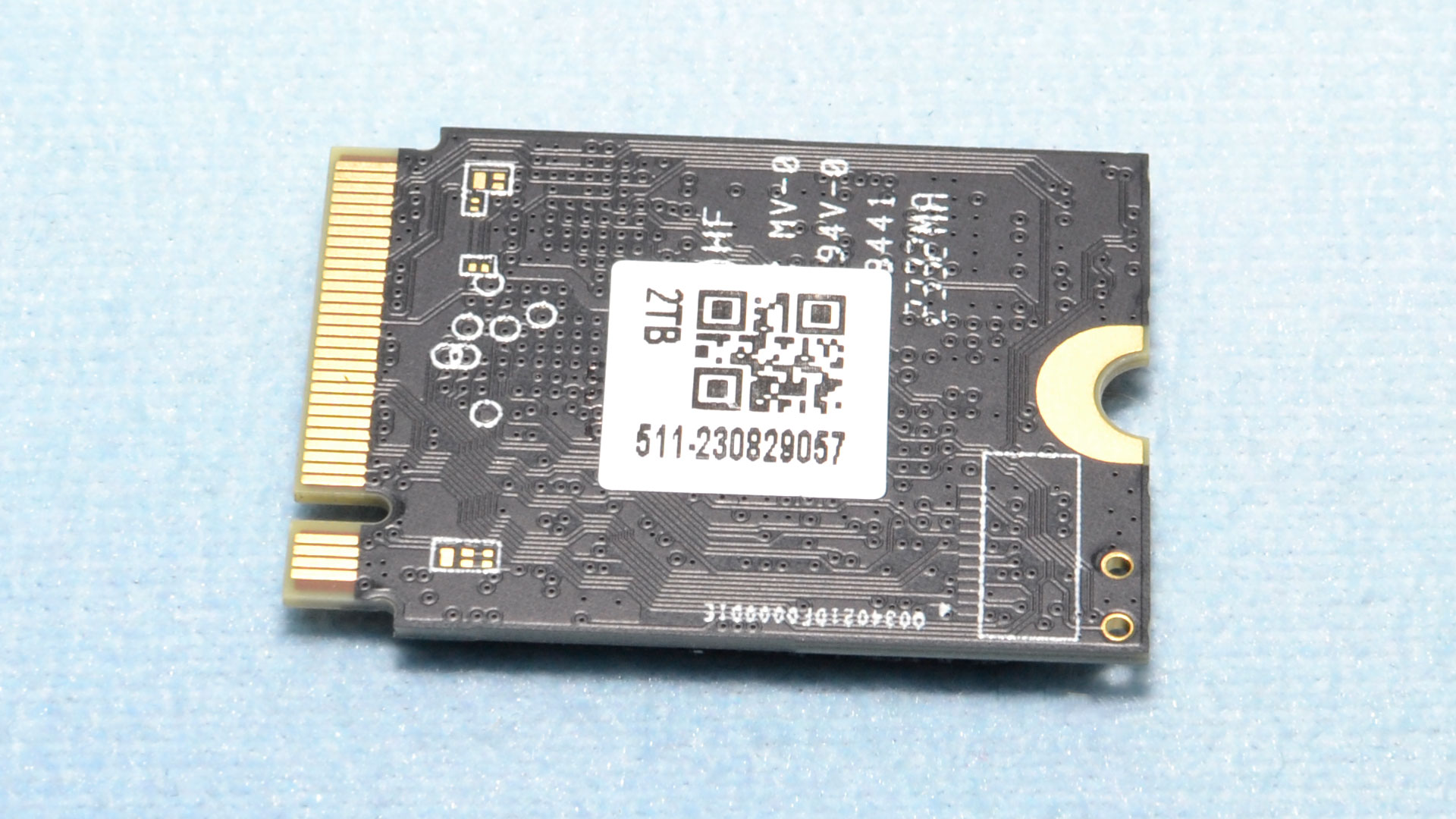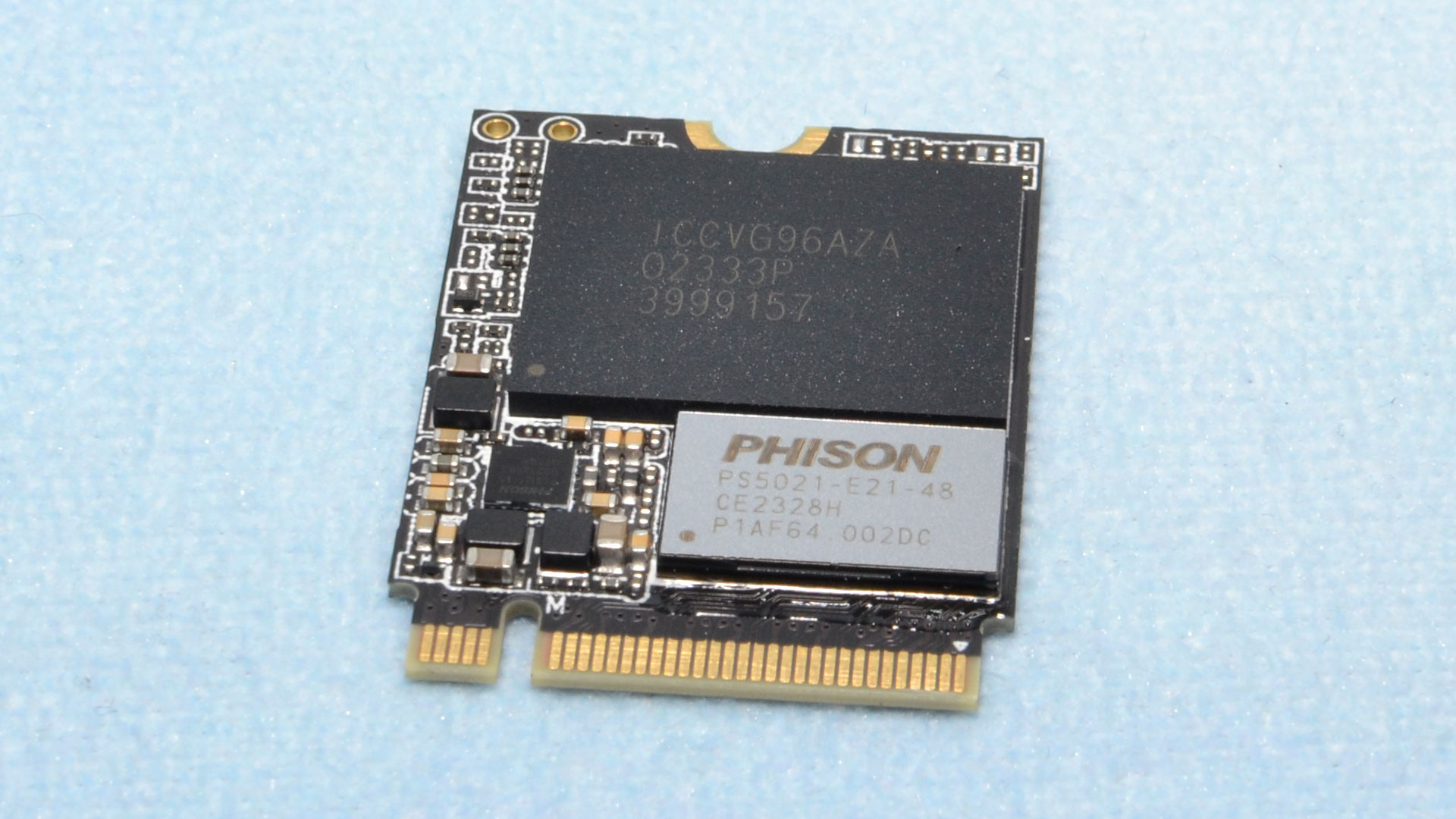Tom's Hardware Verdict
The Silicon Power UD90 2230 is the QLC-based, shorter sibling of the regular UD90. It’s a convenient and efficient way to add more storage to your Steam Deck or other portable gaming device, but it’s not the fastest option.
Pros
- +
Up to 2TB in the M.2 2230 form factor
- +
Good PCIe 3.0 performance for the Steam Deck
Cons
- -
QLC flash
- -
Weaker PCIe 4.0 and sustained performance
Why you can trust Tom's Hardware
If you have your heart set on 2TB of capacity for your Steam Deck, ASUS ROG Ally, or other portable gaming system, you’re about to discover another great M.2 2230 SSD. The Silicon Power UD90 2230, which by name is a shorter version of the previous value champion UD90, is an excellent choice for upgrading your internal storage. It’s not limited to 2TB; it is designed for 500GB and 1TB, but like most QLC drives, it’s best at higher capacity. Performance feels good enough, and you know what to expect from Silicon Power - a less expensive alternative to otherwise identical hardware from better-known manufacturers. But that’s not to say the UD90 2230 is without its surprises.
The UD90 2230 performs well in PCIe 3.0 mode and in the Steam Deck - which is restricted to PCIe 3.0 - but, as expected from QLC flash, it doesn’t peak as high with PCIe 4.0. Of course, there aren't many TLC options available at 2TB, with the best example being the OEM WD PC SN740 or its equivalent retail part in the WD Black SN770M. For QLC, there’s long been the OEM Micron 2400, but retail options have since ramped up, starting with the Sabrent Rocket Q4 2230, Addlink S91, Teamgroup MP44S, and the Inland QN446. This has put downward pressure on pricing, making 2TB fairly affordable for portable systems - which aren’t limited to gaming devices or even those with M.2 2230, as an extender works just fine for 2242 slots.
There is some question about whether or not a 2TB QLC SSD is needed: TLC options are more plentiful and performant at 1TB and below, and these drives also have had market pressure to lower prices. Portable systems universally have microSD slots and, in the worst case, can rely on external storage. However, these systems are often lovingly cared-for investments, and securing 2TB early for internal storage is tempting. That’s where drives like the UD90 2230 are best, but if you are on a strict budget, you can shave some off the price by going with QLC over TLC at lower capacities without too much loss, as demonstrated in this review.
Specifications
| Pricing | N/A | $68.97 | $165.97 |
|---|---|---|---|
| Form Factor | M.2 2230 | M.2 2230 | M.2 2230 |
| Interface / Protocol | PCIe 4.0 x4 | PCIe 4.0 x4 | PCIe 4.0 x4 |
| Controller | Phison E21T | Phison E21T | Phison E21T |
| DRAM | No (HMB) | No (HMB) | No (HMB) |
| Flash Memory | 176-Layer Micron QLC | 176-Layer Micron QLC | 176-Layer Micron QLC |
| Sequential Read | 4,700 MB/s | 4,900 MB/s | 5,000 MB/s |
| Sequential Write | 1,700 MB/s | 3,200 MB/s | 3,200 MB/s |
| Random Read | N/A | N/A | N/A |
| Random Write | N/A | N/A | N/A |
| Security | N/A | N/A | N/A |
| Endurance (TBW) | 300 TB | 600 TB | 1,200 TB |
| Part Number | SP500GBP44UD9007 | SP01KGBP44UD9007 | SP02KGBP44UD9007 |
| Warranty | 5-year | 5-year | 5-year |
The Silicon Power UD90 2230 is available at 500GB, 1TB, and 2TB, with only the last two SKUs being currently available for purchase. Those two are at $68.97 and $165.97, respectively, during the time of review. However, prices are rapidly changing, so be sure to engage in comparison shopping. Silicon Power rates this model for up to 5,000 / 3,200 MB/s, with the 500GB model rated at up to 4,700 / 1,700 MB/s.
The relatively low sequential write performance for the 500GB model suggests that it’s QLC, which is both good and bad. It’s a good thing because it might be a less expensive option at that capacity than the standard TLC drives. The Addlink S91, which is QLC at 1TB and 2TB but not 512GB, uses BiCS5 TLC for the smallest capacity. TLC usually performs better, which is a negative for the UD90 2230, but on the other hand, BiCS5 is likely to be less efficient. Typically, QLC-based M.2 2230 drives don’t even have a 500/512GB option which makes the UD90 2230 a bit unique - if and when that SKU becomes available.
Silicon Power backs this drive with a 5-year warranty at up to 600TB of writes per TB capacity. This TBW rating is higher than competing QLC drives like the Inland QN446. That shouldn’t be an important consideration for this type of drive, but all else being equal, it could tip the scales in its favor.
Software and Accessories
Silicon Power has a bunch of software for download on its site. This includes an SSD toolbox, a versatile application that yields information on your system and storage with diagnostics and a way to update the drive’s firmware. SP’s other software ranges from file recovery to cloning to encryption, although freeware alternatives exist for many of these functions. Sometimes, it’s best to avoid OEM software solutions, although not all of them are in-house, as the file recovery download is Recuva.
Get Tom's Hardware's best news and in-depth reviews, straight to your inbox.
A Closer Look



This is your standard M.2 2230 SSD. The UD90 2230 is a single-sided drive with an SSD controller and a single package of NAND. 2TB of capacity means that this package is stacked with 16 dies (HDP) of 1Tb QLC, the effective limit of current technology.
Stacking more dies can be challenging for multiple reasons, such as maintaining signal integrity. With this same Phison E21T controller and 512Gb TLC dies, models like the Corsair MP600 Mini faced such an issue that could lead to data loss in specific circumstances. A firmware fix is the cleanest solution, and Phison put out a new revision. In rare scenarios performance is reduced with that fix, but that also is being addressed. No such issue applies here, though, as stacked QLC is immune.
You really have to hold one of these drives in your hands to fully grasp just how small it is, with the realization that this could pack in 4TB if it were double-sided. You always remember your first M.2 SSD, coming from either behemoth 3.5” HDDs or 2.5” SATA SSDs that once felt smallish. An M.2 2280 SSD feels tiny in comparison, and an M.2 2230 somehow reduces that by more than one-half more.
There’s a point here: be careful with these drives. They are delicate in some ways, but not in others. Luckily, it’s harder to bend these than full-length M.2 SSDs. Still, installation means working in a smaller space, so caution and patience are recommended. This is especially true when working with systems with a different offset for M.2 2230 or requiring an M.2 extender, as such installations are atypical. The UD90 2230 does not stand out in any particular way, but at least its single-sided nature does ensure easier handling.
MORE: Best SSDs
MORE: Best External SSDs and Hard Drives
MORE: How We Test HDDs And SSDs
MORE: All SSD Content

Shane Downing is a Freelance Reviewer for Tom’s Hardware US, covering consumer storage hardware.
